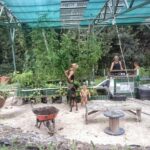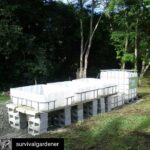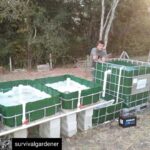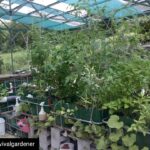The U.N. FAO Aquaponics Bible
This is the official aquaponic food production manual released by the Food and Agriculture Organization of the United Nations.
All of the concerns starting and maintaining an aquaponics system are covered. It’s filled with relevant scientific concepts, practical applications and excellent illustrations. The manual focuses on constructing aquaponics systems out of used IBC shipping containers. This is especially beneficial in 3rd world countries as these containers are inexpensive and a great way to “upcycle”. IBC containers are what we used to construct our first system.
If you’re not familiar with aquaponics, it’s a form of integrated fish and plant farming that does not use soil. Check out the last post on our aquaponics system. It includes a short video tour as well.
You can bookmark this page, or visit this link to download the Aquaponic Food Production Manual.
Our First IBC Aquaponics setup In Costa Rica. Much like the system described in the UN FAO manual.






Aquaponics combines two of the most productive systems in their respective fields.
Recirculating aquaculture systems and hydroponics have experienced widespread expansion in the world not only for their higher yields, but also for their better use of land and water, simpler methods of pollution control, improved management of productive factors, their higher quality of products and greater food safety. Using the correct system for the crop being grown is essential to increase yield while maintaining efficiency, whether this is done through aquaponics or in an indoor environment.
The aquaponic farming system requires energy as well, other than water, to make the system functional. For instance, the significant uses of electric energy in aquaponic system could be – water heaters, air blowers, box fans, pumps, and lights for seedling germination.
Aquaponics is a technique that has its place within the wider context of sustainable intensive agriculture, especially in family-scale applications. It offers supportive and collaborative methods of vegetable and fish production and can grow substantial amounts of food in locations and situations where soil-based agriculture is difficult or impossible. The sustainability of aquaponics considers the environmental, economic and social dynamics. Economically, these systems require substantial initial investment, but are then followed by low recurring costs and combined returns from both fish and vegetables. Environmentally, aquaponics prevents aquaculture effluent from escaping and polluting the watershed.
Aquaponics utilizes less water overall and allows for greater production per square foot when compared to traditional farming methods.
It also does not rely on chemicals for fertilizer, or control of pests or weeds which makes food safer against potential residues. Socially, aquaponics can offer quality-of-life improvements because the food is grown locally and culturally appropriate crops can be grown. At the same time, aquaponics can integrate livelihood strategies to secure food and small incomes for landless and poor households. Domestic production of food, access to markets and the acquisition of skills are invaluable tools for securing the empowerment and emancipation of women in developing countries, and aquaponics can provide the foundation for fair and sustainable socio-economic growth. Fish protein is a valuable addition to the dietary needs of many people, as protein is often lacking in small-scale gardening. Aquaponics is most appropriate where land is expensive, water is scarce, and soil is poor. Deserts and arid areas, sandy islands and urban gardens are the locations most appropriate for aquaponics because it uses an absolute minimum of water. There is no need for soil, and aquaponics avoids the issues associated with soil compaction, salinization, pollution, disease and tiredness. Similarly, aquaponics can be used in urban and peri-urban environments where no or very little land is available, providing a means to grow dense crops on small balconies, patios, indoors or on rooftops.
Comments? Questions?




GIPHY App Key not set. Please check settings